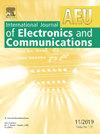Investigating a CNT-based Dickson charge pump with linearly distributed capacitance working in FSL
IF 3.2
3区 计算机科学
Q2 ENGINEERING, ELECTRICAL & ELECTRONIC
Aeu-International Journal of Electronics and Communications
Pub Date : 2025-09-09
DOI:10.1016/j.aeue.2025.156035
引用次数: 0
Abstract
The increasing demand for energy-efficient on-chip high-voltage generation in Internet of Things (IoT) and Internet of Medical Things (IoMT) applications has driven the need for low-power and fast-response charge pump (CP) designs. The interest about these blocks arises in the last decades resulting in the proposal of more accurate models, new topologies, unconventional uses and tropicalized implementations. In this last framework, for the first time, a 4-stage Dickson charge pump with a linearly distributed capacitance strategy is designed and simulated in 32-nm Stanford University’s carbon nanotube field-effect transistor (CNTFET) technology. Simulations were performed for different values of slope parameters a (0, −0.2, −0.5, −0.8) of the proposed linearly distributed capacitance model by varying the input voltages (Vin = 300, 400, and 500 mV). For performing the simulations, total capacitance distribution of (CT), load capacitance (CL) and load resistance (RL) were chosen to be 10 pF, 100 pF, 10 MΩ, respectively, with CL/CT = 10. The simulation results show that the best performance is achieved for slope parameter a = -0.5 with PCE of 78.86 %, VCE of 98.49 %, an output resistance of 0.18 MΩ and power consumption of 79 nW for an input voltage of 400 mV. Further, the impact of process variations of CNTFET on proposed CP for slope parameter a = -0.5 is also investigated in this work. The appraisal performance parameters of the proposed strategy are well-suited for IoT and IoMT applications.
基于碳纳米管的线性分布电容Dickson电荷泵在FSL中工作的研究
物联网(IoT)和医疗物联网(IoMT)应用中对节能片上高压发电的需求不断增长,推动了对低功耗和快速响应电荷泵(CP)设计的需求。在过去的几十年里,人们对这些块产生了兴趣,从而提出了更精确的模型、新的拓扑、非常规的使用和热带化的实现。在最后一个框架中,首次采用斯坦福大学的32纳米碳纳米管场效应晶体管(CNTFET)技术设计并模拟了具有线性分布电容策略的4级Dickson电荷泵。通过改变输入电压(Vin = 300、400和500 mV),对所提出的线性分布电容模型的斜率参数a(0、−0.2、−0.5、−0.8)的不同值进行了仿真。模拟时,选择总电容分布(CT)、负载电容(CL)和负载电阻(RL)分别为10 pF、100 pF、10 MΩ, CL/CT = 10。仿真结果表明,当斜率参数a = -0.5时,PCE为78.86%,VCE为98.49%,输出电阻为0.18 MΩ,输入电压为400 mV时,功耗为79 nW,性能最佳。此外,本文还研究了斜率参数a = -0.5时CNTFET工艺变化对所提出的CP的影响。所提出策略的评估性能参数非常适合物联网和IoMT应用。
本文章由计算机程序翻译,如有差异,请以英文原文为准。
求助全文
约1分钟内获得全文
求助全文
来源期刊
CiteScore
6.90
自引率
18.80%
发文量
292
审稿时长
4.9 months
期刊介绍:
AEÜ is an international scientific journal which publishes both original works and invited tutorials. The journal''s scope covers all aspects of theory and design of circuits, systems and devices for electronics, signal processing, and communication, including:
signal and system theory, digital signal processing
network theory and circuit design
information theory, communication theory and techniques, modulation, source and channel coding
switching theory and techniques, communication protocols
optical communications
microwave theory and techniques, radar, sonar
antennas, wave propagation
AEÜ publishes full papers and letters with very short turn around time but a high standard review process. Review cycles are typically finished within twelve weeks by application of modern electronic communication facilities.

 求助内容:
求助内容: 应助结果提醒方式:
应助结果提醒方式:


